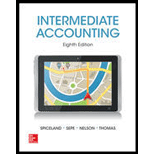
(1)
Note receivable:
Note receivable refers to a written promise for the amounts to be received within a stipulated period of time. This written promise is issued by a debtor or borrower to lender or creditor. Notes receivable is an asset of a business.
To determine: The rate of interest of the noninterest-bearing note.
(1)
Answer to Problem 7.6P
The rate of interest of the noninterest-bearing note is determined as follows:
Compute the amount of remaining discount of note 3:
| Face Value of Note 1 | $300,000 |
| Face Value of Note 2 | 150,000 |
| Face Value of Note 3 | 200,000 |
| Total Face value of Notes | $650,000 |
| Less: Carrying Value of Notes as Per |
(645,000) |
| Remaining Discount on note 3 | $5,000 |
Table (1)
Compute the discount rate for 6 months:
Explanation of Solution
Note 3 is a 6-month noninterest bearing note, with three months remaining. Hence, $5,000 represents the discount for three months. Therefore, the total amount of discount for 6 months is $10,000.
Annualize the discount rate:
Therefore, the discount rate is 10%.
(2)
The accrued interest on note 2.
(2)
Explanation of Solution
The accrued interest on note 2 is determined as follows:
| Total Accrued interest Receivable | $16,000 |
| Less: Interest Accrued on Note 1 | (10,000) (2) |
| Accrued Interest on Note 2 | $6,000 |
Table (2)
Working note:
Compute the explicit interest rate of note 2:
Annualize the discount rate:
Therefore, the Interest rate is 8%.
(3)
The amount of interest revenue to be reported on the income statement of 2016.
(3)
Explanation of Solution
Interest on Notes Receivable:
The amount of interest on notes receivables is calculated as follows:
Compute the amount of interest for the following notes receivable.
| Computation of Interest on Notes receivable | ||||
| Note Number |
Principal ($) |
Interest Rate (%) | Period (Days/Months |
Interest ($) |
| 1 | 300,000 | 10 |
4 Months (August 31 to December 31) |
10,000 (1) |
| 2 | 150,000 | 8 |
6 Months (June 30 to December 31) |
6,000 (2) |
| 3 | 200,000 | 10 |
3 Months (September 30 to December 31) |
5,000 (3) |
| Total Interest to be Reported in the Income Statement of 2016 | 21,000 | |||
Table (3)
Working Notes:
Note 1:
Note 2:
Note 3:
Therefore, the amount of interest revenue to be reported on the income statement of 2016 is $21,000.
Want to see more full solutions like this?
Chapter 7 Solutions
INTERMEDIATE ACCOUNTING
- Please provide the accurate answer to this general accounting problem using valid techniques.arrow_forwardDuring June, the production department of a process operations system completed and transferred to finished goods a total of 82,000 units of product. At the end of May, 18,000 additional units were in process in the production department and were 70% complete with respect to materials. The beginning inventory included a materials cost of $92,400 and the production department incurred a direct materials cost of $276,800 during June. Compute the direct materials cost per equivalent unit for the department using the weighted-average method.arrow_forwardMistral Inc. reported $85,000 in net profit for the year using absorption costing. The company had no units in beginning inventory, planned and actual production was24,000 units and sales were 20,500 units during the year. Variable manufacturing costs were $25 per unit and total budgeted fixed manufacturing overhead was $120,000. There was no underapplied or overapplied overhead reported during the year. Determine the net profit under variable costing.arrow_forward

 AccountingAccountingISBN:9781337272094Author:WARREN, Carl S., Reeve, James M., Duchac, Jonathan E.Publisher:Cengage Learning,
AccountingAccountingISBN:9781337272094Author:WARREN, Carl S., Reeve, James M., Duchac, Jonathan E.Publisher:Cengage Learning, Accounting Information SystemsAccountingISBN:9781337619202Author:Hall, James A.Publisher:Cengage Learning,
Accounting Information SystemsAccountingISBN:9781337619202Author:Hall, James A.Publisher:Cengage Learning, Horngren's Cost Accounting: A Managerial Emphasis...AccountingISBN:9780134475585Author:Srikant M. Datar, Madhav V. RajanPublisher:PEARSON
Horngren's Cost Accounting: A Managerial Emphasis...AccountingISBN:9780134475585Author:Srikant M. Datar, Madhav V. RajanPublisher:PEARSON Intermediate AccountingAccountingISBN:9781259722660Author:J. David Spiceland, Mark W. Nelson, Wayne M ThomasPublisher:McGraw-Hill Education
Intermediate AccountingAccountingISBN:9781259722660Author:J. David Spiceland, Mark W. Nelson, Wayne M ThomasPublisher:McGraw-Hill Education Financial and Managerial AccountingAccountingISBN:9781259726705Author:John J Wild, Ken W. Shaw, Barbara Chiappetta Fundamental Accounting PrinciplesPublisher:McGraw-Hill Education
Financial and Managerial AccountingAccountingISBN:9781259726705Author:John J Wild, Ken W. Shaw, Barbara Chiappetta Fundamental Accounting PrinciplesPublisher:McGraw-Hill Education





